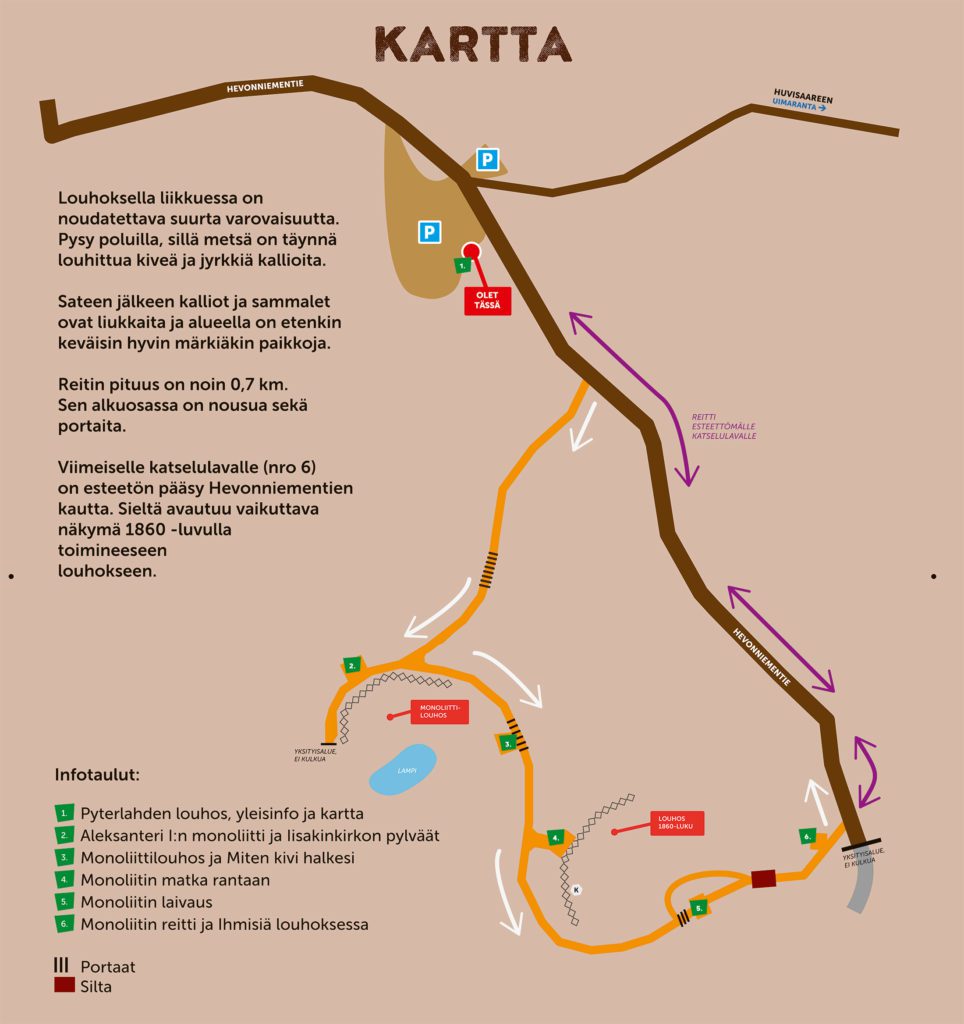The victory column of Alexander I, “the world’s largest monolith”, erected on Palace Square in Saint Petersburg, and the columns of the famous Saint Isaac’s Cathedral in Saint Petersburg, were excavated here in the 1820-30s.
Granite to Saint Petersburg
“Saint Petersburg is the capital of Russia built on a Finnish swamp from Finnish stone” – F. Dostoevsky
The oldest version of Saint Petersburg was a wooden city – only the churches, palaces, and administrative buildings in the centre were brick or stone buildings. At first, they used local limestone, as there were no granite rocks nearby. However, limestone did not withstand the northern climate, so a stronger type of stone was needed, especially for the stone foundations of the buildings. The first signs indicating the use of Finnish granite are from the Vyborg Bay of the 1750s, and in the following decade, new quarries were also opened in Uuraa and the Pitkäpaasi region of Virolahti. Granite gained visibility in the cityscape when the wooden pilings of the embankments of the Neva river and the canals were replaced with stone walls, and granite was used for the facade of the Peter and Paul Fortress and the fence of the Summer Park.
Granite became a very central element in significant construction projects in Saint Petersburg. The outer shell of the Kazan Cathedral, completed in 1811, was still traditional light limestone, but the church hall was celebrated by 56 granite pillars over ten metres in height, polished to shine. In the architecture of the new (fourth) and even more magnificent Saint Isaac’s Cathedral, which was started a little later, the granite pillars got an even bigger role. Festive portals with a total of 48 huge pillars were built on the four sides of the church, and smaller granite pillars surround the tall dome and the bell towers. And even before the completion of Saint Isaac’s Cathedral, the monolith of Alexander I, said to be the largest in the world, was erected on Palace Square, in front of the Winter Palace.
Some of the granite columns of the Kazan church had already been quarried from the Hailniemi region of Virolahti. A few of the pillars of Saint Isaac’s Cathedral also came from there, but the main part of them, as well as Alexander’s monolith, came from the area of this quarry, the rocks of Hevonniemi. Despite their world fame, these giant columns represent only a small part of the stone brought to Saint Petersburg from Virolahti and other parts of Southeast Finland. An incalculable amount of granite has been sunk into the walls of the Neva shore and the Kronstadt fortress. The export of this granite continued until the Russian Revolution (1917). There were forty larger and smaller stone quarries on the shores of Rautalanselkä in Virolahti alone.
Why the stone of Virolahti?
The unique appearance of Virolahti’s red ‘rapakivi’ granite is dominated by ovoids, the grains of round feldspar with a diameter of 1-5 centimetres. The stone type is named pyterlite after the village of Pyterlahti. Despite its name, the ‘rapakivi’ granite is very resistant to the consumption of water, wind, and urban air pollution. Up to three million tons of the Virolahti granite have been used to build Saint Petersburg. The stone gives the city a beautiful look, which will be preserved even for the next generations. The few cracks in the rocks made it possible, among other things, to mine the world’s largest monolith. In addition, due to the suitable geological properties of the stones, the same methods as in the age of the pyramids have been used in mining, transportation, and processing.
This old stone quarry, located in Hevonniemi, in the Pyterlahti village of Virolahti, on the shores of the Gulf of Finland, is known above all for the red granite taken to Saint Petersburg, which was once used to make the world’s largest monolith standing on Palace Square, the column of Alexander I, as well as the columns of Saint Isaac’s Cathedral. The streets of Saint Petersburg as well as the embankments of the Neva river and its canals have also been paved with stones from the quarry.
The columns of Saint Isaac’s Cathedral and the great monolith
The French-born architect Auguste Ricard de Montferrand (1786-1858) designed Saint Isaac’s Cathedral in Saint Petersburg, the 17-meter-tall columns of which were mined from Pyterlahti, no fewer than 48 pieces. Montferrand was also commissioned to design the monument of Alexander I. During his frequent visits to the Pyterlahti quarry, Montferrand had found a flawless spot of thirty metres in the rock. The architect proposed a gigantic monolith, a granite column, as a memorial. Tsar Nicholas I approved the plan, and thus, the excavation work began.
The Pyterlahti quarry had a maximum of 2000 workers. A whole village was formed around the quarry, where there was a chapel in addition to the workers’ accommodation and maintenance buildings for the site. The excavation work was slow, and the technology was rudimentary. The noise at the quarry was deafening. The stones were removed and moved to the shore for transport by manpower. The monolith almost sank into the sea after the support bars broke. In the end, however, it got on the barge and arrived in Saint Petersburg. The monument was unveiled on 11 September 1832, and since then, it has stood tall in the middle of Saint Petersburg.
Mining continued until the beginning of the 20th century. From the 1860s, there is a work management manual carved into the quarry wall, which has survived to be read: “”Z: IOKA: EI: TOTELE: EZÄNTÄ: NIIN: Z: ZAPI: ETZIIÄ: TYÖTÄ: IA: LEIPÄ: NEUWOLLAAN: JOS: HÄN TAHTO: TANEL ARE”
(The one who disobeys the master can look for work and bread on his own, if he wants)
Map
Great care must be taken when moving around the quarry. Stay on the trails as the forest is full of quarried rock and steep cliffs. After the rain, the rocks and mosses are slippery, and there are very wet places in the area, especially in the spring. The length of the route is about 0.7 kilometres. The beginning of it includes a rise and flights of stairs. The last viewing platform (no. 4) has free access through the Hevonniementie road. An impressive view over the quarry that operated in the 1860s opens up from there.
Recommended direction of the tour (white arrow)
Clear route to the viewing platform along the Hevonniementie road (purple arrow)
Stairs; Bridge
- The Pyterlahti quarry, general information and map
- Alexander I’s monolith and the columns of Saint Isaac’s Cathedral
- The monolith quarry and How the stone split
- The monolith’s journey to the shore
- The shipping of the monolith
- The route of the monolith and People in the quarry

Project info
This object has been supported by the Rural Development Programme for Mainland Finland. The Hevonniemi granite quarry in Pyterlahti has been renovated for tourism and camping, open to all, with rural funding granted by the Southeast Finland ELY Center. Project: Quarry and amusement park. Implemented by: Virolahti municipality. Implementation period 2019-2022.
- Info texts: Yrjö Kaukiainen, Siru Ahopelto, Mika Räisänen, Paavo Härmä
- Graphic design and layout of the info signs: RiimuRaami
- Design: UKI Arkkitehdit Oy, Azalea Oy
- Construction: Vaalimaa Asunnot Oy, EM Shaft Engineering Oy
The material work has been supported by the Finnish Cultural Foundation. The project has been prepared by Kaakon Luonto ja Kulttuuri ry, the VILUKKO project in 2012-2013
An online tour in the Pyterlahti quarry
The tour of the Pyterlahti quarry includes five stories related to the history of the place, which are told with a twinkle in the eye and a creative and fun interpretation of history. The quarry’s information signs tell factual information about the history of the place, but the videos of the online tour will let your imagination run wild!
Instructions:
- Download the free SALMI AR app from the app store (Google Play or iOS App Store). The SALMI AR application works best on the latest mobile devices.
- Open the SALMI AR application and enter “Pyterlahti quarry tour” in the search field. Open the package by clicking on the package image.
- Download the package by clicking the Download button.
- When the download is completed, click the “Start Tour” button.
- The map in the SALMI AR application guides you through the route in the planned order. If you want, you can listen and watch the contents of the link in the order you want.
- The numbers marked on the map of the SALMI AR application are the points where the contents come. The application guides you in such a way that the contents become viewable.
- Enjoy the tour of the Pyterlahti quarry!

